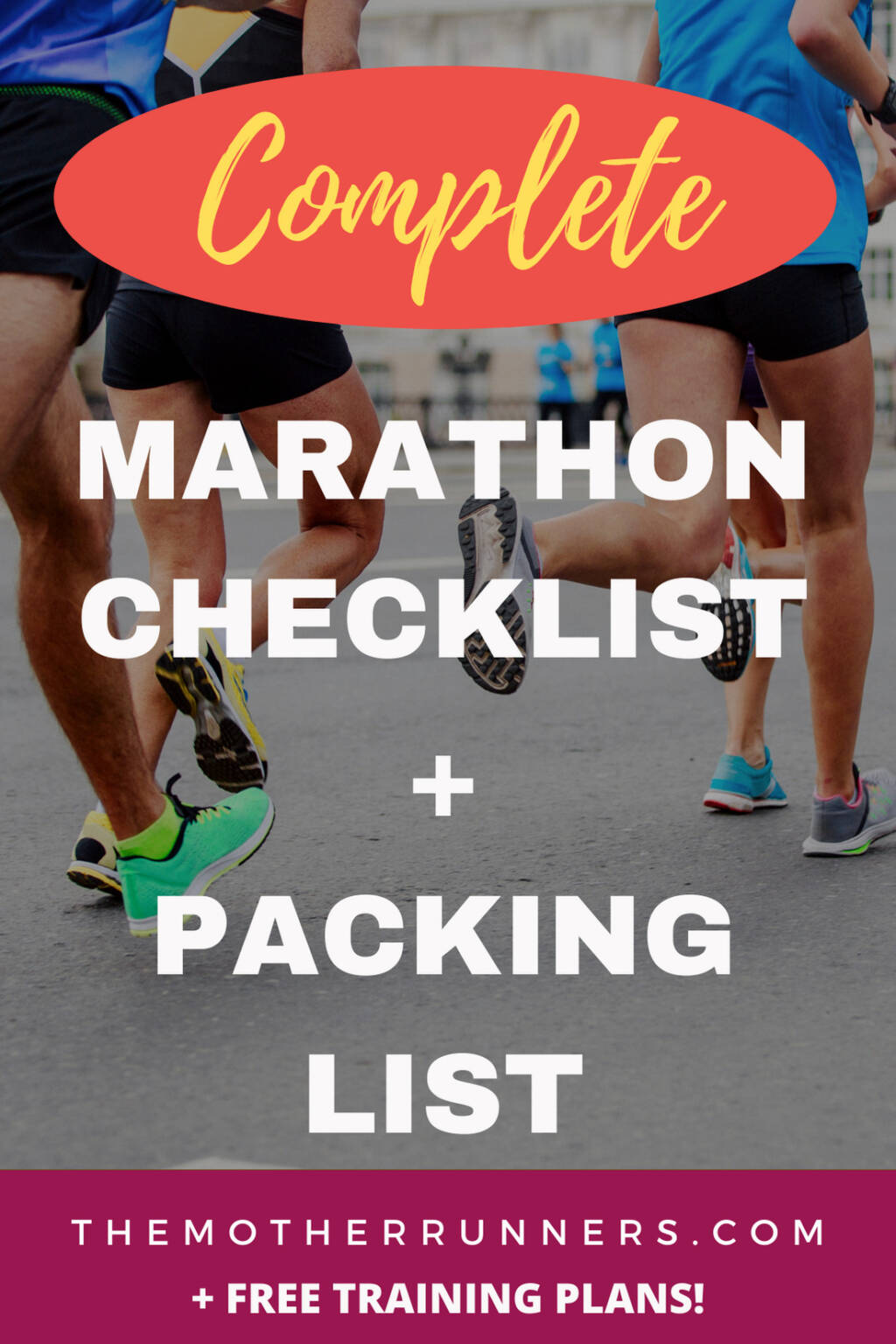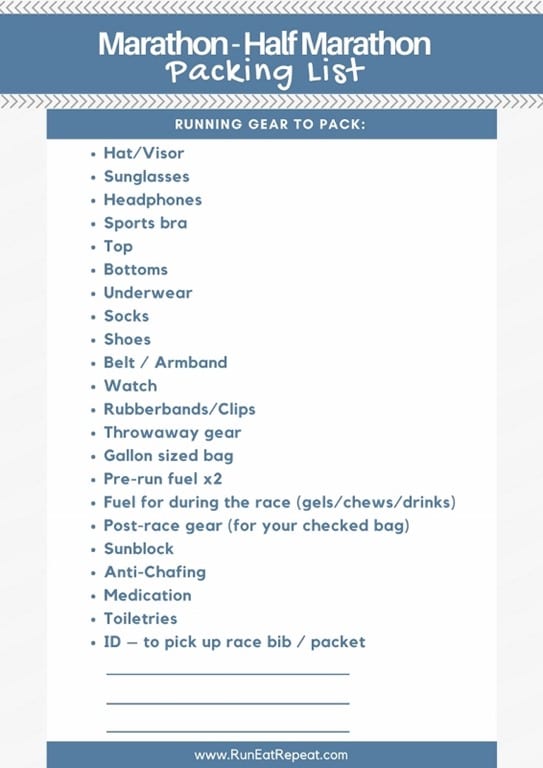Introduction: The Art of Marathon Packing
Embarking on a marathon journey is an exciting endeavor that requires careful planning and preparation. A crucial aspect of this process is creating a comprehensive marathon packing list. By ensuring you have all the necessary gear, clothing, and accessories, you lay the foundation for a successful and enjoyable race experience. This article will guide you through the essentials of marathon packing, covering topics such as clothing, footwear, nutrition, electronics, and more.
Clothing: Dressing for Comfort and Performance
Selecting the right clothing for marathon running is essential for maintaining comfort, regulating body temperature, and preventing chafing or blisters. When creating your marathon packing list, consider the following recommendations:
- Fabrics: Opt for moisture-wicking materials such as polyester or nylon blends, which help keep your skin dry and prevent uncomfortable chafing.
- Layers: Dress in layers to accommodate changing temperatures throughout the race. Consider a base layer, mid-layer, and outer layer for protection against wind and rain.
- Fit: Choose clothing that fits well without being too tight or too loose. Ill-fitting clothing can cause discomfort and restrict movement during the marathon.
- Specific Clothing Items: Include running shorts, moisture-wicking shirts, and socks in your marathon packing list. You may also consider compression garments for improved circulation and support.
Footwear: Choosing the Perfect Running Shoes
Running shoes play a critical role in marathon performance and injury prevention. Selecting the right shoes for your foot type, running style, and terrain can significantly impact your overall race experience. Here are some tips for choosing the perfect running shoes:
- Foot Type: Identify your foot type (neutral, pronated, or supinated) and consider shoes designed for your specific foot type. This can help correct any biomechanical issues and prevent injuries.
- Running Style: Consider your running style and gait. Shoes with extra cushioning or stability features may be beneficial for runners who tend to overpronate or supinate.
- Terrain: Select shoes that are appropriate for the marathon terrain. For example, trail shoes typically offer more grip and protection for off-road running, while road shoes are designed for paved surfaces.
- Popular Shoe Brands and Models: Research popular running shoe brands such as Asics, Brooks, New Balance, Nike, and Saucony. Look for highly-rated models like the Asics Gel-Kayano, Brooks Ghost, or Nike Air Zoom Pegasus.
Nutrition: Fueling Your Body for Optimal Performance
Proper nutrition is vital for marathon training and race day success. A well-balanced diet rich in carbohydrates, proteins, and healthy fats can help optimize your performance and aid in recovery. Here are some recommendations for fueling your body during marathon training and race day:
- Carbohydrate-Rich Foods: Include carbohydrate-rich foods in your diet, such as whole grains, fruits, vegetables, and legumes. These foods provide the necessary energy for long-distance running.
- Hydration: Stay hydrated before, during, and after training and racing. Aim to drink at least 16 to 20 ounces of water a few hours before the marathon and continue hydrating throughout the race.
- Electrolyte Balance: Consider incorporating electrolyte-rich drinks, gels, or chews into your marathon packing list. Electrolytes, such as sodium, potassium, and magnesium, help regulate fluid balance and muscle function.
- Specific Energy Gels, Chews, and Drinks: Research and test various energy gels, chews, and drinks during training to determine which products work best for you. Popular brands include Gu Energy, Clif Shot Bloks, and Nuun.
Electronics: Navigation, Safety, and Entertainment
Electronics can play a significant role in marathon running, providing navigation, safety, and entertainment. When creating your marathon packing list, consider the following devices:
- GPS Watches: A GPS watch can help track your pace, distance, and route during the marathon. Popular brands include Garmin, Polar, and Suunto. Look for features such as long battery life, customizable data screens, and smartphone connectivity.
- Headphones: While some runners prefer to run without music, headphones can provide motivation and entertainment during the marathon. Opt for wireless earbuds or headphones to avoid tangled cords. Popular brands include Jabra, Jaybird, and Bose.
- Safety Lights: Stay visible during nighttime or low-light runs with safety lights. Consider clip-on lights, armbands, or vests with integrated LEDs. Brands like Nathan and Amphipod offer a variety of safety lighting options.
When using electronics during a marathon, be aware of race rules and etiquette. Some races may prohibit the use of headphones or require that GPS watches be set to airplane mode to avoid interference with race timing systems.
Accessories: Enhancing Your Marathon Experience
Accessories can help improve your marathon experience by providing additional support, convenience, and comfort. When creating your marathon packing list, consider the following accessories:
- Hydration Belts: A hydration belt can help you stay hydrated during the marathon without relying solely on water stations. Look for belts with adjustable straps and multiple bottle holders. Popular brands include Fitletic, Nathan, and CamelBak.
- Compression Sleeves: Compression sleeves can help reduce muscle fatigue and soreness during and after the marathon. Consider sleeves for your calves, arms, or feet. Brands like 2XU, CEP, and Zensah offer a variety of compression options.
- Hats: A hat can provide sun protection, warmth, and style during the marathon. Look for lightweight, moisture-wicking materials and adjustable straps. Popular brands include Headsweats, Nike, and Adidas.
- Sunglasses: Protect your eyes from the sun and wind with a pair of running sunglasses. Look for lightweight, flexible frames and polarized lenses. Brands like Oakley, Rudy Project, and Tifosi offer a variety of running sunglasses.
- Gloves: Cold weather or windy conditions may require a pair of running gloves. Look for moisture-wicking materials, touchscreen compatibility, and adjustable cuffs. Popular brands include Nike, The North Face, and Under Armour.
Accessorize based on your personal preferences and the specific conditions you will encounter during the marathon. Remember that the right accessories can make a significant difference in your overall race experience.
Pre-Race Preparation: Getting Ready for the Big Day
Preparing for a marathon involves more than just training. In the days leading up to the race, it’s essential to stay organized and focused on your goals. Here’s a checklist to help you get ready:
- Packing: Create a list of items to pack, including your marathon packing list of clothing, footwear, and accessories. Double-check this list before leaving for the race to ensure you have everything you need.
- Travel: If you’re traveling for the marathon, plan your transportation and accommodations well in advance. Research the race location and familiarize yourself with the course and surrounding area.
- Race Registration: Register for the marathon and print or save your confirmation email. Review the race rules, schedule, and packet pickup information.
- Hydration and Nutrition: In the days leading up to the marathon, focus on hydration and carbohydrate-rich foods. Avoid trying new foods or supplements on race day.
- Rest: Aim for 7-9 hours of sleep each night during the week before the marathon. A well-rested body is more likely to perform at its best on race day.
- Visualization: Visualize yourself crossing the finish line and achieving your goals. This mental preparation can help reduce stress and increase confidence.
By following these steps, you can ensure a smooth and stress-free race day experience.
Post-Race Recovery: Taking Care of Your Body
After completing a marathon, it’s essential to prioritize recovery to help your body heal and prepare for future training. Here’s a post-race recovery plan to follow:
- Stretching: Perform gentle stretches to help reduce muscle tension and promote circulation. Focus on your calves, hamstrings, quadriceps, and hip flexors.
- Hydration: Rehydrate with water, electrolyte drinks, or coconut water to replace lost fluids and electrolytes. Aim for 16-20 ounces of fluid for every pound lost during the marathon.
- Nutrition: Consume a balanced meal with carbohydrates, protein, and healthy fats within 30-60 minutes after the marathon. Consider recovery drinks, protein shakes, or chocolate milk for added nutrition.
- Ice Baths: Submerge your legs in an ice bath for 10-15 minutes to help reduce inflammation and muscle soreness. Alternatively, use cold therapy devices such as ice packs or compression sleeves.
- Massage: Schedule a massage to help release muscle tension, improve circulation, and promote relaxation. Consider using a foam roller or massage gun for self-myofascial release.
- Rest: Allow your body time to rest and recover. Avoid high-intensity workouts or long runs for at least 3-5 days after the marathon.
- Sleep: Prioritize sleep to help your body repair and rejuvenate. Aim for 7-9 hours of sleep each night.
By following this post-race recovery plan, you can help your body recover and prepare for future training and races.







